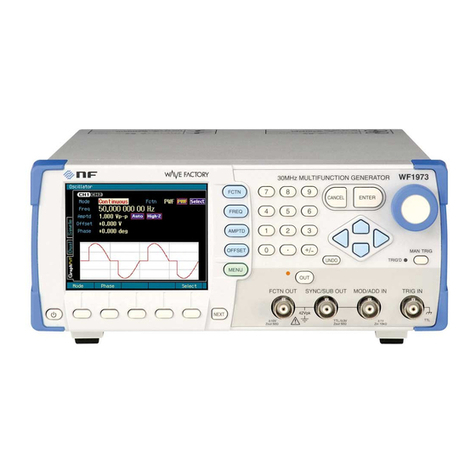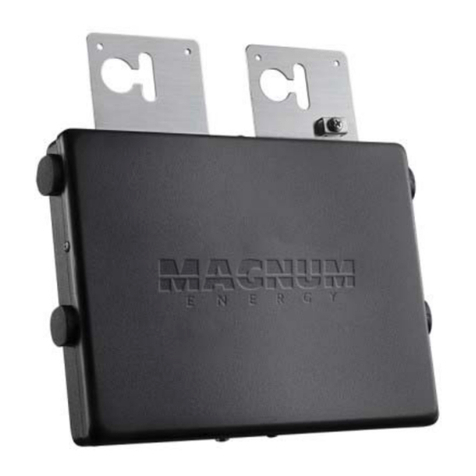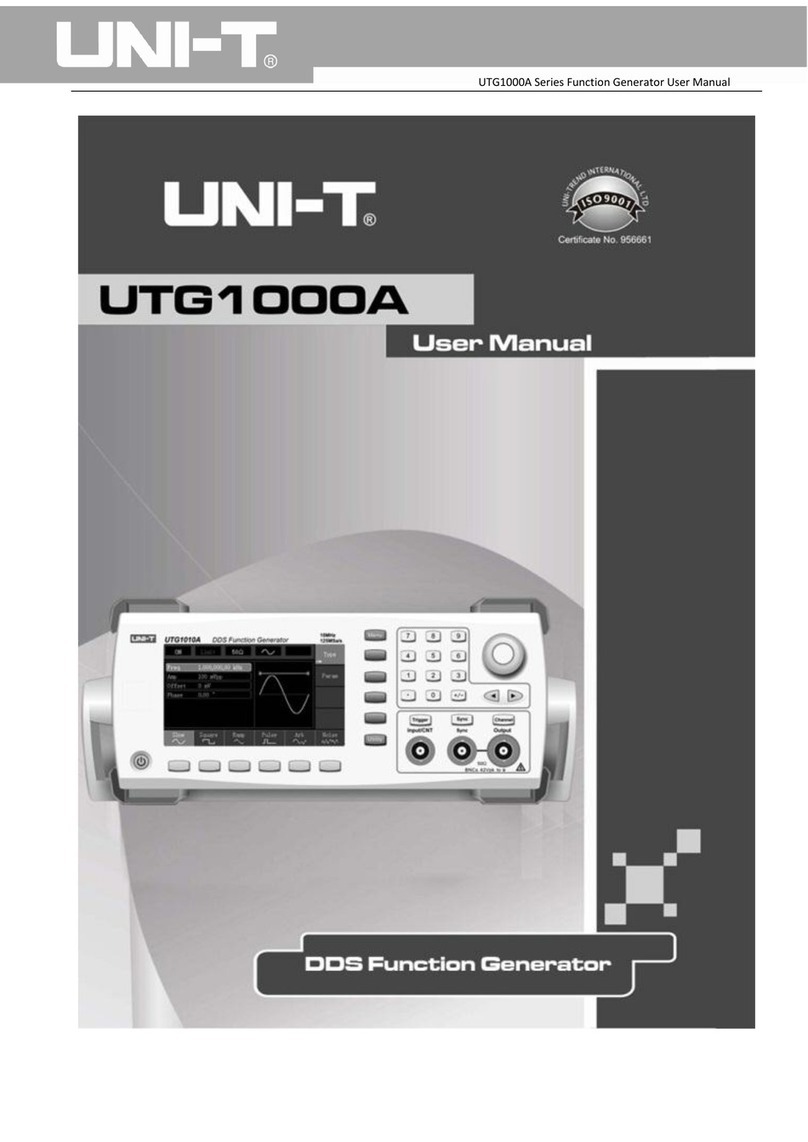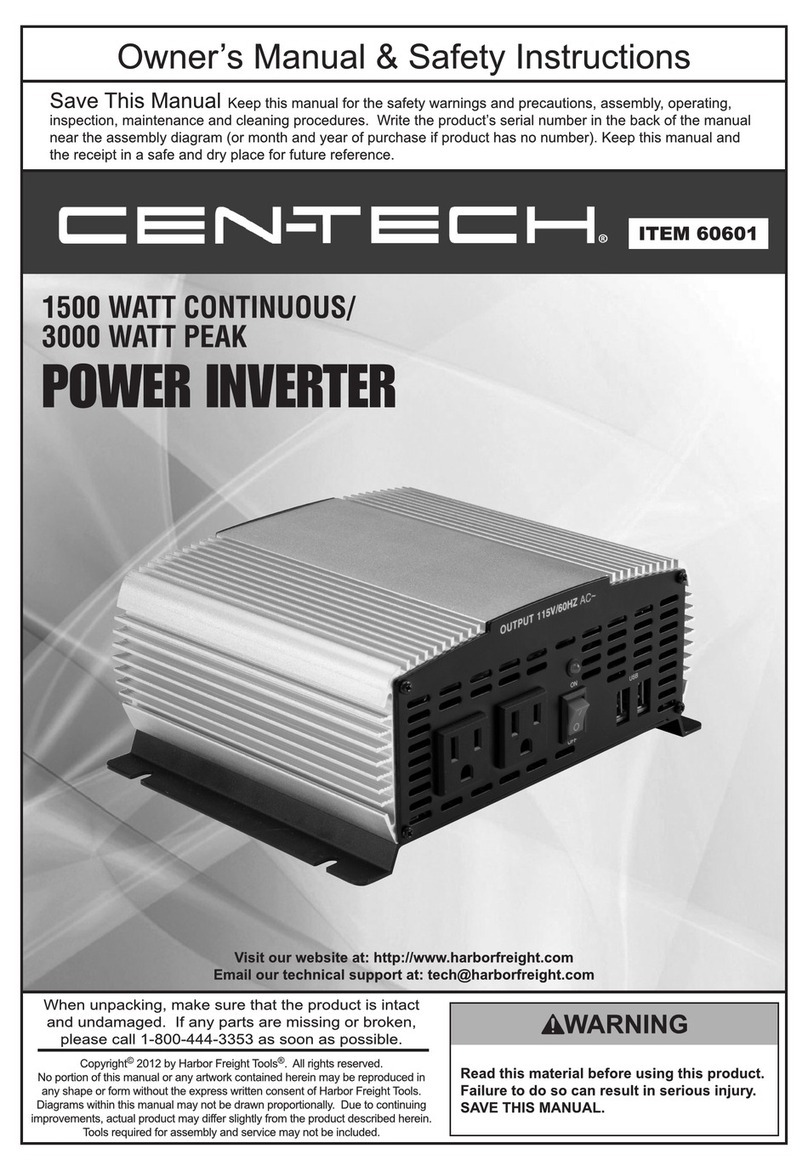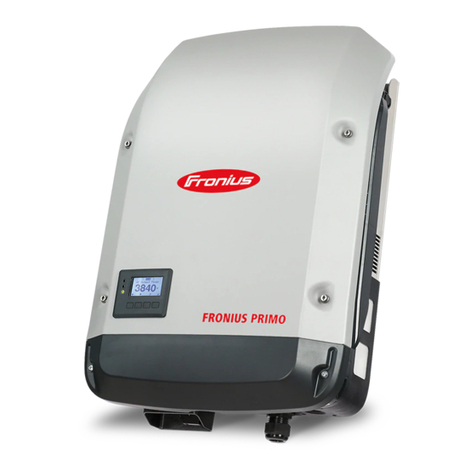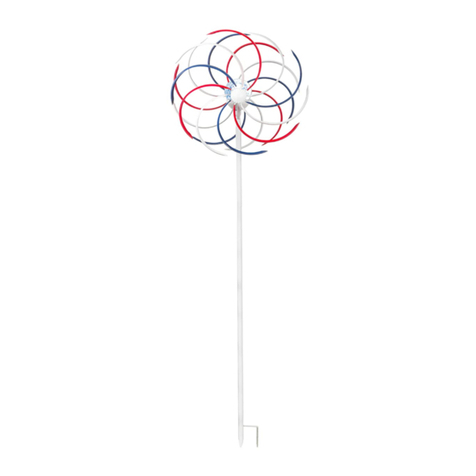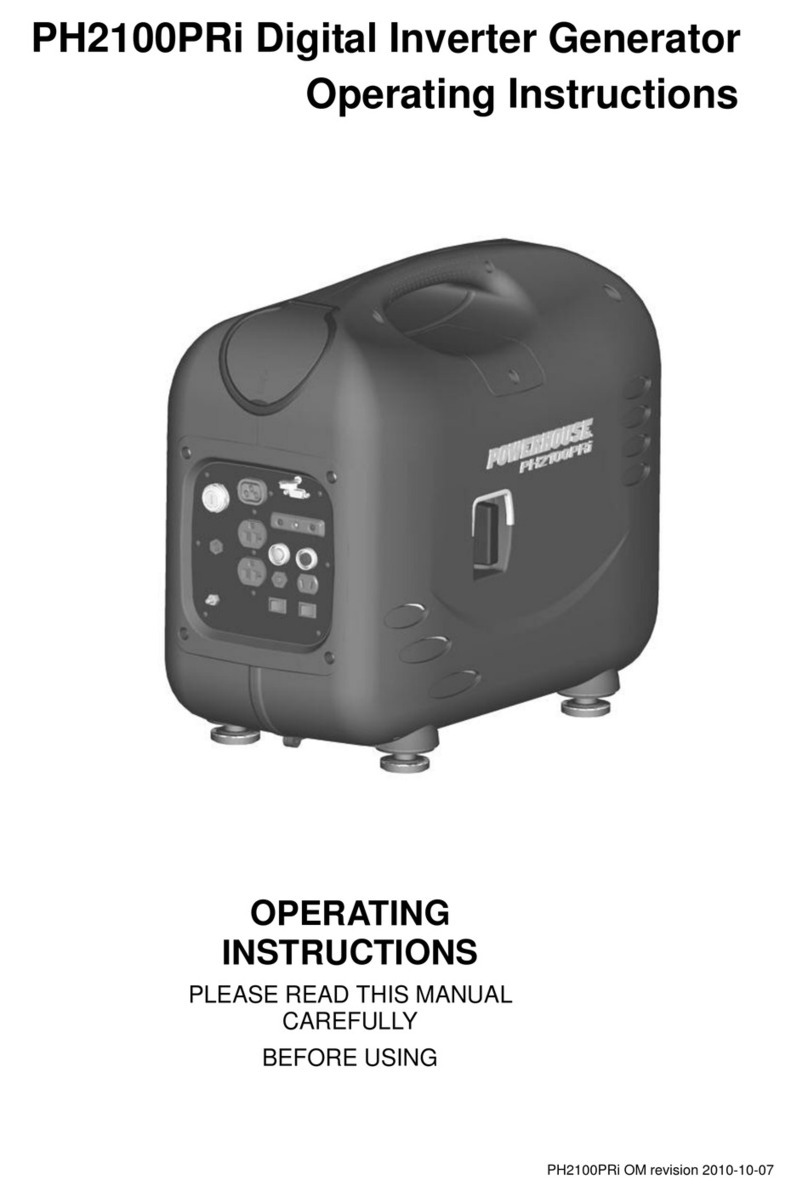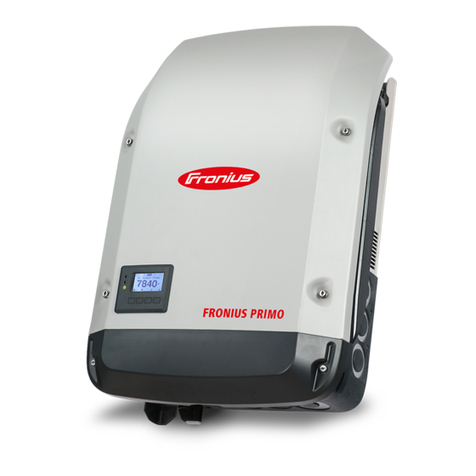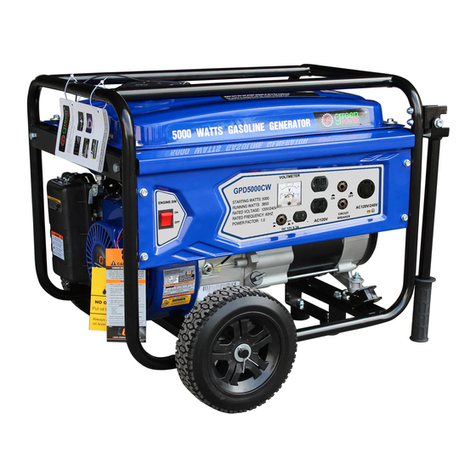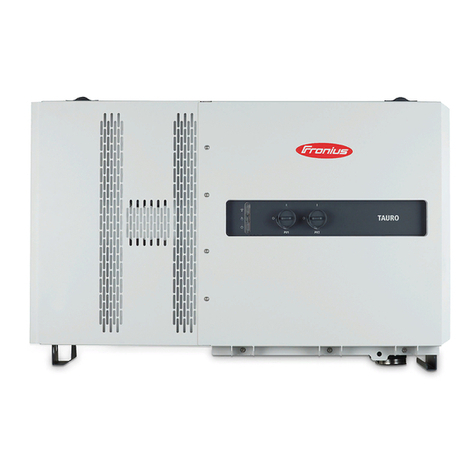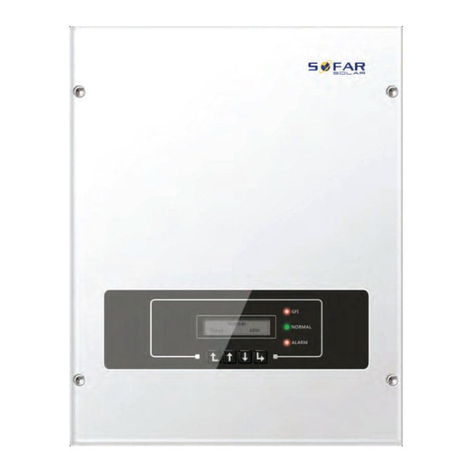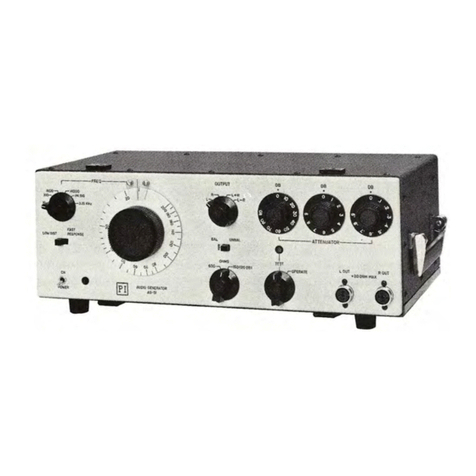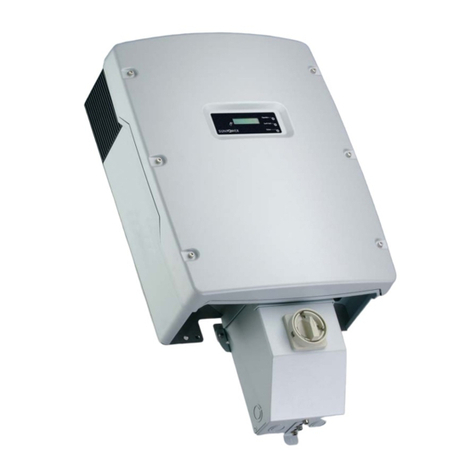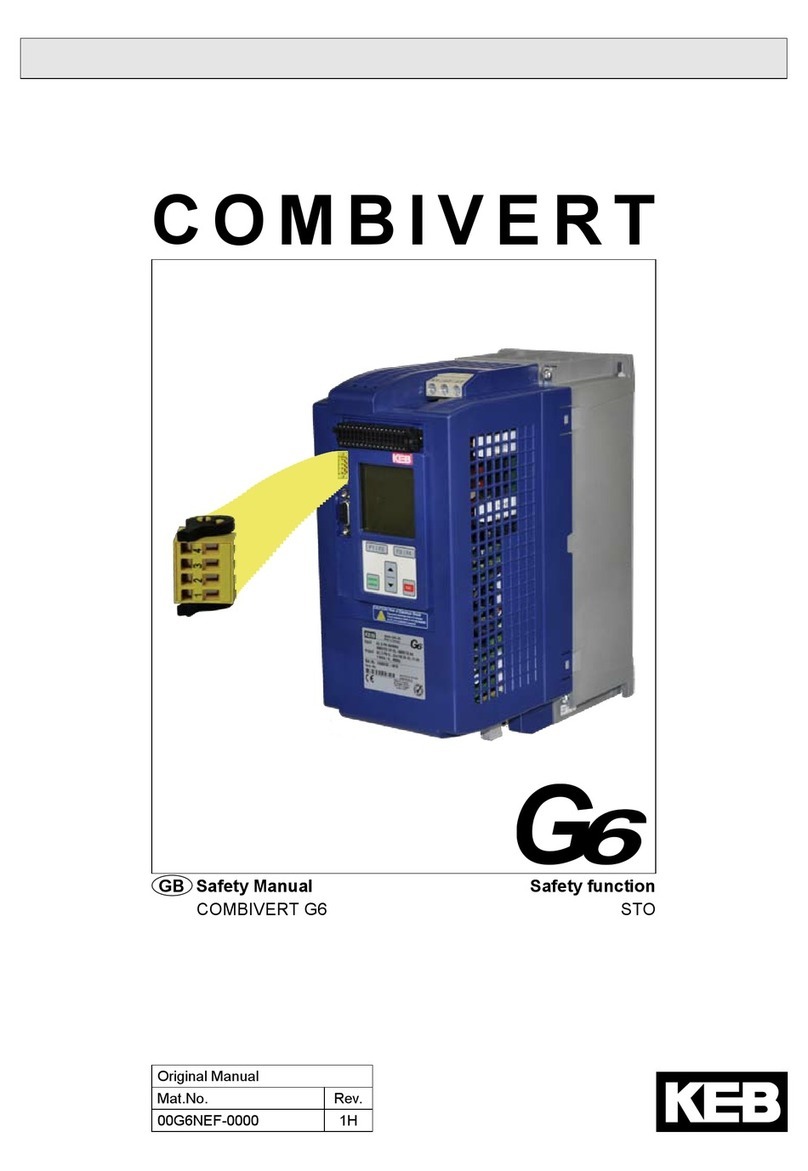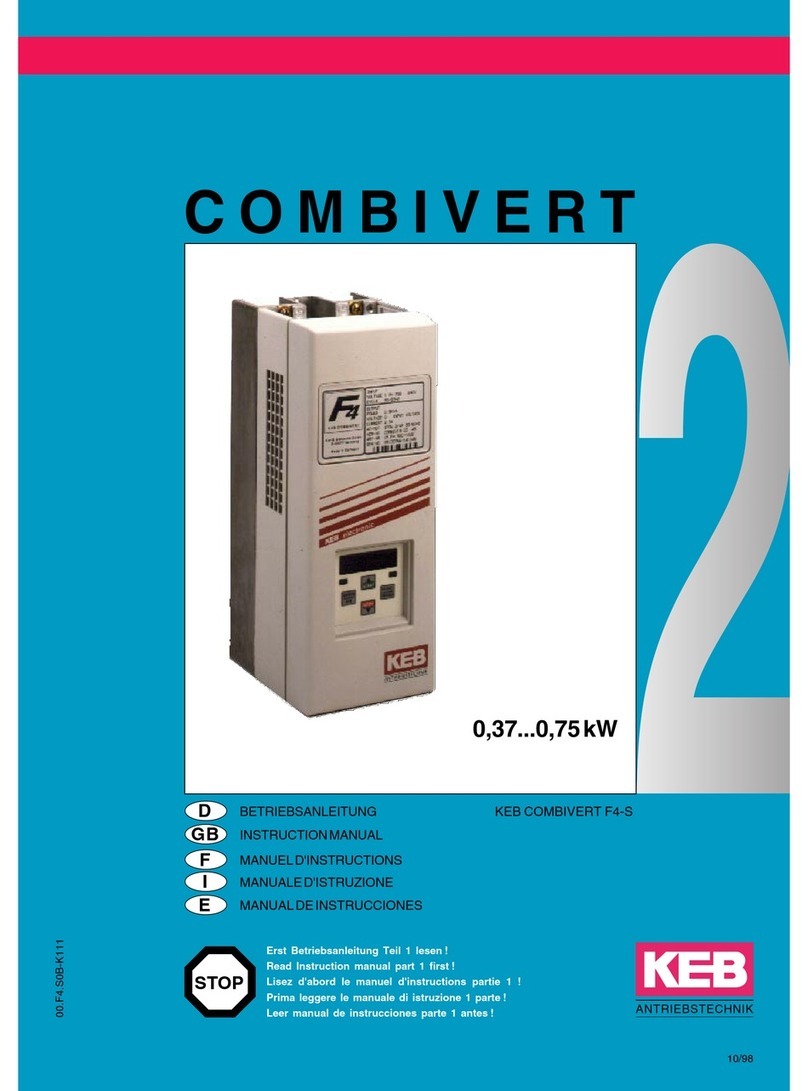NF WAVE FACTORY WF1968 Instruction Manual

MULTIFUNCTION GENERATOR
WF1967/WF1968
Instruction Manual (Operations)
NF Corporation
nbn Austria GmbH


MULTIFUNCTION GENERATOR
WF1967/WF1968
Instruction Manual (Operations)
DA00048287-002


WF1967/WF1968
i
Preface
Thank you very much for purchasing our "Multifunction Generator WF1967/WF1968".
To use the instrument in a safe and correct manner, please first read the next section titled "Safety
Precautions".
Caution symbols used in this manual
The following caution symbols are used in this manual. Be sure to observe these caution symbols and
their contents to ensure the safety of the user and avoid damage to the equipment.
This symbol indicates information for the avoidance of a hazard that may
endanger human life or cause injury during handling of the equipment.
This symbol indicates information for the avoidance of personal injury or
equipment damage during handling of the equipment.
This manual has the following chapter organization.
The instructions for remote control (GPIB, USB, LAN(Option)) are provided in a separate
manual included in the attached CD-ROM.
If using this equipment for the first time, start with "1. Overview."
Operations
1. Overview
This chapter describes the overview and brief operating principles of this product.
2. Preparations Before Use
This chapter describes important preparations before installation and operation.
3. Panels and I/O Terminals
This chapter describes the functions and operations of the switches and I/O terminals on the
panels.
4. Basic Operation
This chapter describes basic operations.
5. Saving and Recalling Settings
This chapter describes how to save and recall the settings.
6. Parameter-Variable Waveforms
This chapter describes the meaning of each parameter and examples of Parameter-Variable
waveforms.
CAUTION
WARNING

WF1967/WF1968
ii
7. Creating Arbitrary Waveforms
This chapter describes how to input and edit arbitrary waveforms from the panel control.
8. Convenient Use of 2-channel Equipment (WF1968 Only)
This chapter describes how to coordinate the settings of two channels.
9. Synchronizing Multiple Units
This chapter describes how to configure a multi-phase oscillator by connecting multiple units
of this product.
10. Using External Frequency Reference
This chapter describes how to use external frequency reference.
11. Using Sequence Oscillation
This chapter describes how to set and operate sequence oscillation.
12. Using User-defined Units
This chapter describes the units which users can define by themselves.
13. Other Utility Settings
This chapter describes how to set display and operational details.
14. Troubleshooting
This chapter describes the error messages and handling when problems occur.
15. Maintenance
This chapter describes how to perform the operation inspection and performance test.
16. List of Initial Settings
This chapter describes the initial settings.
17. Specifications
This chapter describes the product's specifications (functions and performance).

WF1967/WF1968
iii
Safety Precautions
To ensure safe use, be sure to observe the following warnings and cautions.
NF Corporation shall not be held liable for damages that arise from a failure to observe these
warnings and cautions.
This product is a Class I instrument (with protective conductor terminal)that conforms to the JIS
and IEC insulation standards.
Be sure to follow the contents of the instruction manual.
This instruction manual contains instructions for safe operation and use of this product.
Please read this manual first before using the product.
All of the warning items contained in this instruction manual are intended for preventing risks
that may lead to serious accidents. Be sure to observe these warnings.
Be sure to ground the product.
This product uses a line filter, which may cause electric shock if the product is not grounded.
This product is grounded automatically by connecting a three-pin power supply plug to a power
supply outlet with a protective earth contact.
Check the power supply voltage.
This product operates on the power supply voltage indicated in section “2.3 Grounding and
Power Supply Connection” in this instruction manual.
Prior to connecting the power supply, check that the outlet voltage matches the rated power
voltage of the product.
If you suspect a problem
If this product emits smoke, a strange odor, or an unusual sound, immediately pull the power
cable and stop using it.
If such an abnormality occurs, do not let anyone use this product until it has been repaired, and
immediately report the problem to NF Corporation or one of our representatives.

WF1967/WF1968
iv
Do not use this product when gas is present.
Operation of the instrument in a gaseous environment could cause an explosion.
Do not remove the cover.
This product has high-voltage portions inside. Do not remove its cover.
Inspections of the product's interior should only be performed by service technicians authorized
by NF Corporation. Do not touch the inside of the instrument.
Do not modify the product.
Do not modify the instrument under any circumstances. Modification of the instrument could
cause unexpected accidents or failures. NF Corporation has the right to refuse to repair any
instruments modified by unauthorized persons.
Safety-related symbols
The general definitions of the safety-related symbols used on this product and in the instruction
manual are provided below.
Instruction Manual Reference Symbol
This notifies the user of potential hazards and indicates that he/she must refer to the
instruction manual.
Electric Shock Danger Symbol
This symbol indicates locations that present a risk of electric shock under specific
conditions.
Warning Symbol
This symbol indicates information for the avoidance of hazards such as
electric shock that may endanger human life or cause injury during handling
of the equipment.
Caution Symbol
This symbol indicates information for the avoidance of damage to the
equipment during handling.
Other symbols
This mark indicates that the outer conductor of the connector is connected to the
enclosure.
This mark indicates that the outer conductor of the connector is insulated from the
enclosure.
However, for safety reasons it indicates that the potential difference from the grounding
CAUTION
WARNING

WF1967/WF1968
v
potential is restricted to 42Vpk or less (since this product is grounded when being used,
the potential of the enclosure equals the grounding potential).
Requesting waste disposal
To protect the environment, ensure that this device is disposed of by an appropriate industrial
waste processor. A battery is not used in this product.

WF1967/WF1968
vi

WF1967/WF1968
vii
Table of Contents
Page
Preface ...............................................................................................................i
1. Overview ..........................................................................................................................1-1
1.1 Features ..................................................................................................................1-2
1.2 Operating Principles ................................................................................................1-4
2. Preparations Before Use ..................................................................................................2-1
2.1 Checking Before Use...............................................................................................2-2
2.2 Installation ...............................................................................................................2-3
2.3 Grounding and Power Supply Connection ...............................................................2-5
2.4 Firmware Update.....................................................................................................2-6
2.5 Calibration ...............................................................................................................2-6
3. Panels and I/O Terminals..................................................................................................3-1
3.1 Panel Component Names and Functions.................................................................3-2
3.1.1 Front Panel of WF1967.....................................................................................3-2
3.1.2 Rear Panel of WF1967 .....................................................................................3-3
3.1.3 Front Panel of WF1968.....................................................................................3-4
3.1.4 Rear Panel of WF1968 .....................................................................................3-5
3.2 I/O Terminals ...........................................................................................................3-6
3.2.1 Waveform Output (FCTN OUT).........................................................................3-7
3.2.2 Synchronization/Sub-output (SYNC/SUB OUT)................................................3-8
3.2.3 External Modulation/Addition Input (MOD/ADD IN).........................................3-10
3.2.4 External Trigger Input (TRIG IN).....................................................................3-11
3.2.5 External 10MHz Frequency Reference Input (10MHz REF IN) .......................3-12
3.2.6 Frequency Reference Output (REF OUT).......................................................3-13
3.2.7 Multi-I/O (MULTI I/O) ......................................................................................3-15
3.3 Cautions on Floating Ground Connection..............................................................3-18
4. Basic Operations ..............................................................................................................4-1
4.1 Power On/Off and Restoration of Settings ...............................................................4-2
4.1.1 How to Turn Power On/Off................................................................................4-2
4.1.2 Restoration of Settings at Power-on .................................................................4-3
4.2 Screen Configuration and Operation........................................................................4-6
4.2.1 Screen Configuration........................................................................................4-6
4.2.2 Switching Display Format with Tabs (To Display Waveform Graph)..................4-8
4.2.3 To use USB flash memory(Switching with tab)................................................4-10
4.2.4 Top Menu........................................................................................................4-11
4.3 Basic Settings and Operations...............................................................................4-12
4.3.1 To Change Frequency, Amplitude, and Other Values......................................4-12

WF1967/WF1968
viii
4.3.2 To Change Waveforms ...................................................................................4-15
4.3.3 Shortcut Keys for Changing Basic Parameters...............................................4-16
4.3.4 Functions of ENTER/CANCEL/UNDO Key .....................................................4-17
4.3.5 Change Display Unit.......................................................................................4-18
4.3.6 CH1/CH2 Switching Key and Active Channel (WF1968 Only).........................4-20
4.3.7 Operations Available on Utility........................................................................4-21
4.3.8 To Restore Initial Settings...............................................................................4-23
4.3.9 Output On/Off .................................................................................................4-23
4.4 Setting for Main Items............................................................................................4-26
4.4.1 Text Display Screen in Continuous Oscillation Mode......................................4-26
4.4.2 To Set Oscillation Mode..................................................................................4-27
4.4.3 To Set Waveforms ..........................................................................................4-28
4.4.4 To Set Frequency ...........................................................................................4-28
4.4.5 To Set Period..................................................................................................4-29
4.4.6 To Set Phase..................................................................................................4-30
4.4.7 To Set the Synclator Function.........................................................................4-32
4.4.8 To Set Amplitude.............................................................................................4-33
4.4.9 To Set DC Offset.............................................................................................4-35
4.4.10 To Set Output Level with High/Low Level........................................................4-36
4.4.11 To Set Waveform Polarity and Amplitude Range.............................................4-38
4.4.12 How to Use Auto Range/Range Hold for Output Voltage ................................4-40
4.4.13 To Set Load Impedance..................................................................................4-41
4.4.14 To Add External Signal....................................................................................4-42
4.4.15 To Set Duty of Square Wave...........................................................................4-44
4.4.16 To Set Pulse Width and Rising/Falling Time of Pulse Wave............................4-46
4.4.17 To Set Ramp Wave Symmetry........................................................................4-49
4.4.18 To Set the Equivalent Noise Bandwidth ..........................................................4-49
4.4.19 To Select Sub Output......................................................................................4-49
4.4.20 To Use Sub Waveforms ..................................................................................4-50
4.5 Using Variable Parameter Waveforms ...................................................................4-52
4.6 Using Arbitrary Waveforms ....................................................................................4-53
4.7 Setting and Operation of Modulation......................................................................4-54
4.7.1 Modulation Types............................................................................................4-54
4.7.2 Screen for Setting and Operation of Modulation .............................................4-55
4.7.3 Common Settings and Operation of Modulation..............................................4-58
4.7.4 Setting FM......................................................................................................4-61
4.7.5 Setting FSK ....................................................................................................4-62
4.7.6 Setting PM......................................................................................................4-63
4.7.7 Setting PSK....................................................................................................4-64
4.7.8 Setting AM......................................................................................................4-66
4.7.9 Setting AM (DSB-SC) .....................................................................................4-68
4.7.10 Setting DC Offset Modulation .........................................................................4-69

WF1967/WF1968
ix
4.7.11 Setting PWM...................................................................................................4-70
4.8 Setting and Operation of Sweep............................................................................4-71
4.8.1 Sweep type (Sweep type)...............................................................................4-71
4.8.2 Screen for Setting and Operation of Sweep....................................................4-71
4.8.3 Common Setting and Operation of Sweep......................................................4-74
4.8.4 Setting Frequency Sweep...............................................................................4-82
4.8.5 Setting Phase Sweep .....................................................................................4-83
4.8.6 Setting Amplitude Sweep................................................................................4-84
4.8.7 Setting DC Offset Sweep................................................................................4-85
4.8.8 Setting Duty Sweep........................................................................................4-86
4.9 Setting and Operation of Burst...............................................................................4-88
4.9.1 Burst Oscillation Types(Burst mode)...............................................................4-88
4.9.2 Screen for Setting and Operation of Bursts.....................................................4-88
4.9.3 Auto burst.......................................................................................................4-90
4.9.4 Trigger burst ...................................................................................................4-93
4.9.5 Gate Oscillation..............................................................................................4-98
4.9.6 Triggered Gate Oscillation............................................................................4-102
5. Saving and Recalling Settings..........................................................................................5-1
5.1 Procedure to Save Settings.....................................................................................5-2
5.1.1 To save to build on memory..............................................................................5-2
5.1.2 To save to USB flash memory...........................................................................5-3
5.2 Procedure to Recall Settings ...................................................................................5-4
5.2.1 To recall from build on memory.........................................................................5-4
5.2.2 To recall from USB flash memory .....................................................................5-5
5.3 Restoring Saved Contents to Initial Settings............................................................5-6
5.4 Changing Setting Memory Name.............................................................................5-6
5.5 USB Flash Memory Operations ...............................................................................5-7
5.5.1 File List.............................................................................................................5-7
5.5.2 To Change the Current Folder ..........................................................................5-7
5.5.3 Creating Folders...............................................................................................5-7
5.5.4 Deleting Folders ...............................................................................................5-7
5.5.5 Time stamp of files............................................................................................5-7
6. Variable Parameter Waveforms ........................................................................................6-1
6.1 Categories...............................................................................................................6-2
6.2 Meaning of Each Parameter and Waveform Examples............................................6-3
6.2.1 Outline..............................................................................................................6-3
6.2.2 Steady Sine Group ...........................................................................................6-4
6.2.3 Transient Sine Group......................................................................................6-10
6.2.4 Pulse Group....................................................................................................6-14
6.2.5 Transient Response Group.............................................................................6-20
6.2.6 Surge Group...................................................................................................6-24
6.2.7 Other Waveforms Group (Others Group)........................................................6-26

WF1967/WF1968
x
7. Creating Arbitrary Waveforms...........................................................................................7-1
7.1 Basics......................................................................................................................7-2
7.2 Display Procedure and Overview of Screen for Creating/Editing Arbitrary Waveforms7-3
7.3 Creating New Arbitrary Waveform............................................................................7-5
7.4 Simple Arbitrary Waveform Creating Example .........................................................7-6
7.5 Outputting Created Arbitrary Waveform ...................................................................7-7
7.6 Saving Created Arbitrary Waveform.........................................................................7-7
7.6.1 Saving to Internal Memory................................................................................7-8
7.6.2 Saves to USB Flash Memory............................................................................7-8
7.7 To Use the SavedArbitrary Waveform .....................................................................7-9
7.7.1 To Retrieve From Internal Memory..................................................................7-10
7.7.2 To Retrieve From USB Flash Memory.............................................................7-11
7.8 To Delete the Saved Arbitrary Waveform ...............................................................7-12
7.8.1 To Delete From Internal Memory ....................................................................7-12
7.8.2 To Delete From USB Flash Memory ...............................................................7-12
7.9 Identifying Memory Space Required for Saving Arbitrary Waveforms ....................7-13
8. Convenient Use of 2-channel Equipment ...................................................................................8-1
8.1 Outline.....................................................................................................................8-2
8.2 Copying Setting between Channels.........................................................................8-3
8.3 Unifying Settings of 2 Channels...............................................................................8-5
8.4 Phase Synchronization between Channels..............................................................8-6
8.5 Maintaining to Same Frequency (2-Channel Coordination, 2-Phase).......................8-7
8.6 Keeping Frequency Difference Constant (2-Channel Coordination, 2-Tone)............8-9
8.7 Keeping Frequency Ratio Constant (2-Channel Coordination, Ratio) ....................8-11
8.8 Obtaining Differential Output (2-Channel Coordination, Differential)......................8-13
8.9 Obtaining Double Output Voltage(2-Channel Coordination, Differential 2).............8-14
9. Synchronizing Multiple Units.............................................................................................9-1
9.1 Connection Procedure.............................................................................................9-2
9.2 Performing Synchronization.....................................................................................9-4
10.Using External Frequency Reference.............................................................................10-1
10.1 Purpose of Using External Frequency Reference ..................................................10-2
10.2 Connection and Usage Procedure of External Frequency Reference....................10-2
11. Using the Sequence Oscillation......................................................................................11-1
11.1 Sequence Oscillation Example ..............................................................................11-2
11.2 Basics....................................................................................................................11-4
11.3 In-Step Processing Flow......................................................................................11-12
11.4 Setting and Operation Procedure.........................................................................11-13
11.5 Saving Created Sequence...................................................................................11-17
11.5.1 Saving to the Built-In Memory of Main Body.................................................11-17
11.5.2 Saving to the USB Flash Memory.................................................................11-18
11.6 Using the Saved Sequence .................................................................................11-19
11.6.1 Recalling from the Built-In Memory............................................................... 11-19

WF1967/WF1968
xi
11.6.2 Recalling from the USB Flash Memory......................................................... 11-19
11.7 Deleting the Saved Sequence..............................................................................11-20
11.7.1 Deleting from the Built-In Memory ................................................................ 11-20
11.7.2 Deleting from the USB Flash Memory...........................................................11-20
11.8 Outline of Screen................................................................................................. 11-21
11.9 Individual Description of Step Control Parameters...............................................11-23
11.10 Tips for Sequence Creation ................................................................................. 11-24
12.Using User-defined Units................................................................................................12-1
12.1 About User-defined Unit ........................................................................................12-2
12.2 Display and Setting in User-defined Unit ...............................................................12-2
12.3 Defining User-defined Units...................................................................................12-3
13.Other Utility Settings.......................................................................................................13-1
13.1 Selecting Remote Interface [Remote] ....................................................................13-2
13.2 Display Setting [Display]........................................................................................13-2
13.3 Modify Knob and Modify Direction Setting [Modify Direction].................................13-2
13.4 Operation Sound Setting [Sound] ..........................................................................13-3
13.5 Self-Diagnosis [Self Check] ...................................................................................13-3
13.6 Product Information Display [Information]..............................................................13-3
14.Troubleshooting..............................................................................................................14-1
14.1 Error Messages at Power-on .................................................................................14-2
14.2 Error Messages during Operation..........................................................................14-3
14.3 Conflict Messages for Modulation..........................................................................14-7
14.4 Conflict Message for Sweep ..................................................................................14-8
14.5 Conflict Message for Burst.....................................................................................14-9
14.6 Sequence Compiler Message..............................................................................14-10
14.7 Suspected Failure................................................................................................ 14-11
15.Maintenance...................................................................................................................15-1
15.1 Outline...................................................................................................................15-2
15.2 Operation Inspection..............................................................................................15-4
15.3 Performance Test...................................................................................................15-5
15.3.1 Frequency Accuracy Test................................................................................15-5
15.3.2 Sine Wave Amplitude Accuracy Test...............................................................15-6
15.3.3 DC Offset Accuracy Test.................................................................................15-6
15.3.4 Sine Wave Amplitude/Frequency Characteristics Test ....................................15-7
15.3.5 Sine Wave Total Harmonic Distortion Test ......................................................15-9
15.3.6 Sine Wave Harmonic Spurious Test................................................................15-9
15.3.7 Sine Wave Non-harmonic Spurious Test.......................................................15-10
15.3.8 Square Wave Duty Accuracy Test.................................................................15-10
15.3.9 Square Wave Leading/Trailing Time Test......................................................15-11
15.3.10 Time Difference Between Channels for 2-Phase (WF1968 Only)..................15-11
16.List of Initial Settings ......................................................................................................16-1
17.Specifications .................................................................................................................17-1

WF1967/WF1968
xii
17.1 Oscillation Mode....................................................................................................17-2
17.2 Waveform ..............................................................................................................17-2
17.2.1 Standard Waveform........................................................................................17-2
17.2.2 Arbitrary Waveform.........................................................................................17-2
17.3 Frequency, Phase..................................................................................................17-3
17.3.1 Frequency.......................................................................................................17-3
17.3.2 Phase .............................................................................................................17-4
17.4 Output Characteristics ...........................................................................................17-4
17.4.1 Amplitude .......................................................................................................17-4
17.4.2 DC Offset........................................................................................................17-5
17.4.3 Load Impedance Setting.................................................................................17-5
17.4.4 Waveform Output............................................................................................17-6
17.4.5 Synchronization/Sub-Output...........................................................................17-6
17.5 Signal Characteristics............................................................................................17-7
17.5.1 Sine Wave ......................................................................................................17-7
17.5.2 Square Wave..................................................................................................17-8
17.5.3 Pulse Wave ....................................................................................................17-9
17.5.4 Ramp Wave....................................................................................................17-9
17.5.5 Noise..............................................................................................................17-9
17.5.6 Parameter-Variable Waveform......................................................................17-10
17.6 Modulated Oscillation Mode................................................................................. 17-11
17.6.1 General.........................................................................................................17-11
17.6.2 FM................................................................................................................17-12
17.6.3 FSK ..............................................................................................................17-13
17.6.4 PM................................................................................................................17-13
17.6.5 PSK..............................................................................................................17-13
17.6.6 AM................................................................................................................17-13
17.6.7 DC Offset Modulation ...................................................................................17-14
17.6.8 PWM.............................................................................................................17-14
17.7 Sweep Oscillation Mode ......................................................................................17-14
17.7.1 General.........................................................................................................17-14
17.7.2 Frequency Sweep.........................................................................................17-17
17.7.3 Phase Sweep ...............................................................................................17-17
17.7.4 Amplitude Sweep..........................................................................................17-17
17.7.5 DC Offset Sweep..........................................................................................17-17
17.7.6 Duty Sweep..................................................................................................17-18
17.8 Burst Oscillation Mode.........................................................................................17-18
17.9 Synclator Function...............................................................................................17-19
17.10 Trigger.................................................................................................................17-20
17.11 Sequences...........................................................................................................17-21
17.12 Other I/Os............................................................................................................17-22
17.13 2-Channel Coordination (WF1968 only)...............................................................17-23

WF1967/WF1968
xiii
17.14 Synchronization of Multiple Units.........................................................................17-25
17.15 User-defined Unit.................................................................................................17-26
17.16 Other Functions...................................................................................................17-26
17.17 Options................................................................................................................17-27
17.18 General Characteristics .......................................................................................17-27

WF1967/WF1968
xiv
Figures and Tables
Page
Figure 1-1 WF1967 Block Diagram........................................................................................1-4
Figure 1-2 WF1968 Block Diagram........................................................................................1-5
Figure 3-1 Front Panel of WF1967.........................................................................................3-2
Figure 3-2 Rear Panel of WF1967 .........................................................................................3-3
Figure 3-3 Front Panel of WF1968.........................................................................................3-4
Figure 3-4 Rear Panel of WF1968 .........................................................................................3-5
Figure 3-5 Multi-I/O connector pin configuration diagram.....................................................3-16
Figure 3-6 Cautions on floating ground connection for WF1967 ..........................................3-19
Figure 3-7 Cautions on floating ground connection for WF1968 ..........................................3-19
Table 3-1 Signals Selectable for Synchronization/Sub-output................................................3-8
Table 3-2 Multi-I/O connector pin assign..............................................................................3-16

WF1967/WF1968
1-1
1. Overview
1.1 Features ..................................................................................................................1-2
1.2 Operating Principles ................................................................................................1-4

1.1 Features
WF1967/WF1968
1-2
1.1 Features
The WAVE FACTORY "WF1967 Multifunction Generator" and "WF1968 Multifunction Generator" are
multifunctional oscillators based on DDS (Direct Digital Synthesizer).
The WF1967 features one channel and the WF1968 features two channels.
Maximum Frequency: 200MHz (Sine wave), 70MHz (Square wave, Pulse)
Frequency Accuracy: ±(3ppm+6pHz), Maximum high resolution of 0.01µHz Supports a
10MHz External Frequency Reference
Maximum Output Voltage: 20Vp-p/open (10Vp-p/50Ω, 110MHz or less), 4Vp-p/open
(2Vp-p/50Ω, 110MHz to 200MHz), Minimum Output Voltage: 0V (Can reach 0 using
Amplitude control)
Standard Waveforms with Multivariable Parameters: Sine wave, Square wave (variable duty),
Pulse (variable pulse width/duty, rising time, falling time), Ramp wave (variable symmetry),
CF control Sine wave (variable crest factor), Staircase Sine wave (variable step number),
Gaussian pulse (variable σ), Sin(x)/x (variable number of zero crossings), exponential rise/fall
(variable time constant), Damped oscillation (variable oscillation frequency, damping time
constant), Pulse surge (variable rise, duration time), Trapezoid wave (variable rise, fall, upper
width), etc.
Synclator function to output an external input signal at the same frequency.
Maintains the flatness of frequency characteristics (Sine wave amplitude) during frequency
sweeps and frequency modulation.
Output waveform resolution: Approximately 16 bit (retains high resolution across a wide range
of output voltages)
High capacity arbitrary waveform memory: Maximum 1Mi words, storage capacity of 128
waveforms/4Mi words (Mi expresses 220=1048576 as per IEC 60027-2/ IEEE 1541-2002)
Continuous phase and uninterrupted waveform during frequency change and frequency sweep
Square wave and Pulse with high resolution, variable duty of 0.0001%
Pulse with variable rising time, falling time
Various oscillation modes
Continuous oscillation mode
Modulation: FM, FSK, PM, PSK, AM, DC Offset Modulation, PWM
Sweep: Frequency, phase, amplitude, DC offset, and duty
Burst oscillation : Auto burst, Trigger burst, Gate oscillation, Triggered gate oscillation
Synclator function: Any waveform can oscillate at the same frequency as that supplied to the
external trigger input terminal.
Sequence Oscillation: Waveform/Frequency/Phase/Amplitude/DC Offset and Square wave
duty, Constant value /Linear interpolation, Jump/Repeat/Hold/Branch.
Sequence function for easy test waveform creation and editing
Flexible waveform creation by combining with standard waveforms with variable parameters
Supports rapid change and sweep of frequency, phase, amplitude, etc.
Intuitive user interface with a WQVGA high resolution TFT color LCD
This manual suits for next models
1
Table of contents
Other NF Inverter manuals

